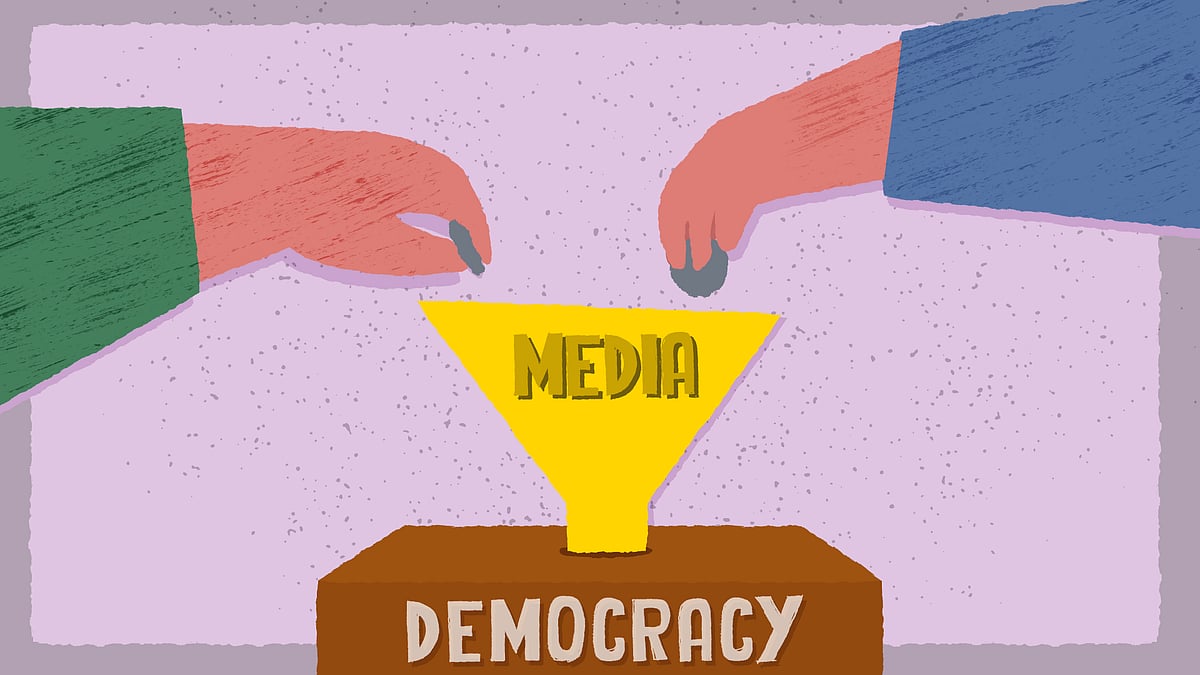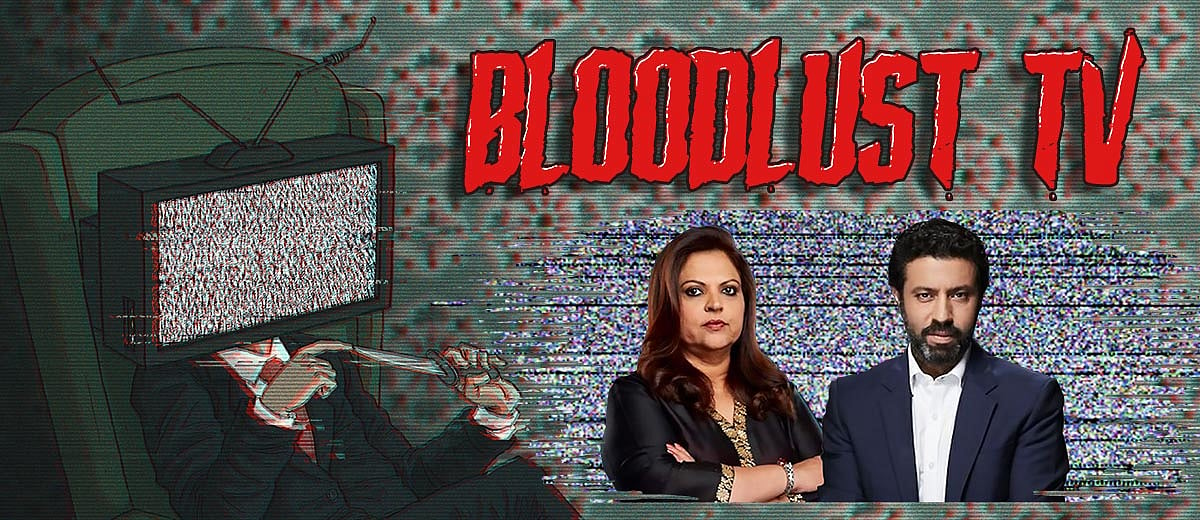Who pays Sudarshan News to spew hate? You do, through your government
RTI responses show us how the channel’s government ad expenditure spiked in 2017, even as other channels lost money.
Suresh Chavhanke. Naam toh suna hi hoga.
The chief editor of Sudarshan News is a popular public spectacle. While some channels pass off propaganda as news, Sudarshan News doesn’t bother. Whether it’s misinformation or straight-up disinformation, it’s a torchbearer of spreading hate — and it’s proud of it.
Why else would the channel celebrate World Environment Day with a spiel on how the rising Muslim population in India warns of a “Muslim takeover”? Or have its chief editor Suresh Chavhanke arrested in 2017 for inciting communal hatred in Uttar Pradesh?
And, more recently, pontificate that Muslims are “infiltrating” the civil services? This is the context of the ongoing court case against Sudarshan News, whose inflammatory content was called “insidious”, “rabid”and “divisive propaganda” by the Supreme Court. The court restrained it from broadcasting its programme on “UPSC Jihad”.
During one of the hearings on September 15, Justice KM Joseph commented on the need for transparency in ownership patterns of media houses, whose revenue models should be made available for public access.
Which brings us very neatly to our central question: Where is Sudarshan News getting the money to fund its “campaigns”, which is how it refers to its reportage?
Short answer: Some of the money comes from you.
Taxpayers' money used to fund hate
In 2019, Newslaundry found that some of the programmes on the channel are sponsored by the UP government and thus, by extension, the taxpayer.
Since last year, Reetika Khera and Anmol Somanchi have been gathering data, from government websites and Right to Information responses, on the central government's advertisement expenditure, including the amount going to Sudarshan News.
Khera is an associate professor of economics at IIT Delhi and Somanchi is an independent researcher. The RTI responses were sought from the Bureau of Outreach and Communication (BOC) under the Union Ministry of Information and Broadcasting. The BOC was formed by merging the Directorate of Advertising and Visual Publicity and two other I&B departments.
The results threw up some interesting patterns.
The data on government TV advertisement expenditure spans 2011-12 to 2018-19. Before the Bharatiya Janata Party came to power in 2014, Sudarshan got negligible central government money for ads. It received nothing in 2011-12, Rs 2.2 lakh in 2012-13, and Rs 1.2 lakh in 2013-14.
However, in 2014-15, the first financial year with the BJP in power at the Centre, government ads to Sudarshan increased by over 20 times in a single shot to Rs 23.3 lakh. They continued to rise in subsequent years, peaking at Rs 81.3 lakh in 2017-18, as shown in Figure 1.

Figure 2 presents yearly trends of government ads to Sudarshan between 2011-12 and 2018-19. The blue line and the left y-axis presents what share of Sudarshan’s total revenue came from government ads. From just over zero percent in 2013-14, it rose steadily to 2.7 percent in 2015-16.
In 2017-18 came the real spike when central government ads accounted for 8.1 percent of Sudarshan News’s total revenue. This dropped marginally to seven percent in 2018-19.
The black line along with the right y-axis tells us what share of the government’s total TV ad expenditure went to Sudarshan. We see a similar trend here as well. At its peak in 2017-18, ads to Surdarshan made up 0.5 percent of the government’s total TV ad expenditure, a significant increase from the previous years.

Based on another set of RTIs filed under the BOC, we know that 2017-18 saw the share of government ad expenditure on electronic media fall significantly compared to the previous three or four years. This is also the year when electronic media came under fire in the legislative assembly for its “damaging” portrayal of legislators and ministers. It was also the year when there was a call for “a single watchdog” for both print and electronic media.
Popular channels like Aaj Tak suffered a 70 percent reduction in money received from government ad expenditure, from Rs 8.1 crore in 2016-17 to Rs 2.4 crore in 2017-18.
Zee News too saw a similar 71 percent reduction from Rs 4.11 crore in 2016-17 to Rs 1.19 crore in 2017-18. NDTV 24x7 saw a reduction of 65 percent from its previous year.
Sudarshan News, on the other hand, received Rs 81.3 lakh in 2017-18, the highest amount it had ever received thus far since 2011-12. In other words, while other leading channels were facing significant cuts in terms of government ad revenue, Sudarshan News enjoyed an increase of 440 percent from the previous year (Rs 15.8 lakh).
Now, here’s where it gets really interesting.
Remember how Chavhanke was arrested for inciting communal hatred? At the time, he was also facing rape charges. Try and remember which year this was.
You guessed it: April of 2017, when his channel was wallowing in government ad expenditure.
Which is not to say that Sudarshan News is financially thriving.
Figure 3 presents the profits and losses after tax recorded by the channel (black line) between 2011-12 and 2018-19. In three of the last five financial years, Sudarshan recorded net losses after tax, most significantly in 2016-17 when it lost close to Rs 8 crore.

As testament to its financial troubles, in August 2016, credit rating agency ICRA downgraded all of Sudarshan’s credit instruments from a rating of BB to D. This implies that Sudarshan’s credit instruments “are in default or are expected to be in default soon”. The ICRA noted that one of the reasons for this was “a significant decline in operating scale on account of weak advertisement sales in FY2016 resulting in pressure on liquidity.”
No definite claims can be made but given the channel’s poor financial position in 2016-17, the significant increase in government ads in 2017-18 appears to be a godsend. Moreover, as Figure 3 shows, from 2014-15, the rupee value of government ads received has been greater than or almost equal to profits after tax in all years.
But Sudarshan’s financial woes didn’t end in 2016-17. In 2018-19, it reported losses again of nearly Rs 2 crore. Interestingly, in February 2018, the ICRA moved Sudarshan to the “issuer not cooperating” category since the channel’s management refused to disclose any information to the agency, despite repeated requests.
Why then does the government continue to give ads to a media house that’s not only a likely credit defaulter, but also extremely opaque about its financial position to even credit rating agencies?
State-sponsored hate
In 2013 during the devastating Muzaffarnagar riots, Sudarshan News was sent a showcause notice by the Ministry of Information and Broadcasting for violation of policies. The channel was also pulled up for “instigating violence”. Unsurprisingly, Chavhanke maintained that the channel had a “clean history record” and had only been “appealing to viewers to remain calm”.
Sudarshan also has a long history of misinformation and disinformation. In 2017, it carried an image of a Bangladeshi activist and dubbed him a “Rohingya criminal”. In 2018, the channel was issued a notice by the Delhi Minorities Commission for referring to residents in North Delhi’s Bawana as “Bangladeshis” and “Rohingyas”. In the same year, even the Uttar Pradesh police asked Chavhanke to “stop spreading misleading news”.
And the less said about “UPSC Jihad”, the better.
Newslaundry reached out to Sudarshan News and the DAVP for comment but received no response. We were further informed by Divakar Mishra of Sudarshan that Suresh Chavhanke would only respond to our queries if we "apologised for printing false information about him". When asked to specify what he meant, he was unable to cite any instances.
It’s easy to disassociate yourself from this wave of hate seen in the media. It’s as easy as switching off your television or not watching a channel. There’s always someone else to blame.
But this time, you can’t shrug it off. Your money played a part in enabling Sudarshan to air a debate on how Islam has “killed” Hinduism. Your money enables Suresh Chavhanke to walk into his studio every single day and spew hate.
It’s time we asked ourselves uncomfortable questions about the part we play in this. Aren’t we duty-bound, as tax-paying, voting citizens, to hold a government accountable when it not only fails to deter hate speech but instead actively funds it?
The problem doesn’t end with Chavhanke and his channel. But hey, it’s a good place to start.
This story is part of a series based on data from RTIs and how governments at the Centre advertise with the media.
***
Independent media has a critical role in sustaining democracy, telling stories that need to be told and asking questions that require answers. Support independent journalists by paying to keep news free. Subscribe to Newslaundry today.
 There's something rotten in the state of Indian media. Public funding might help
There's something rotten in the state of Indian media. Public funding might help Bloodlust TV: Calling out India’s hate media
Bloodlust TV: Calling out India’s hate media